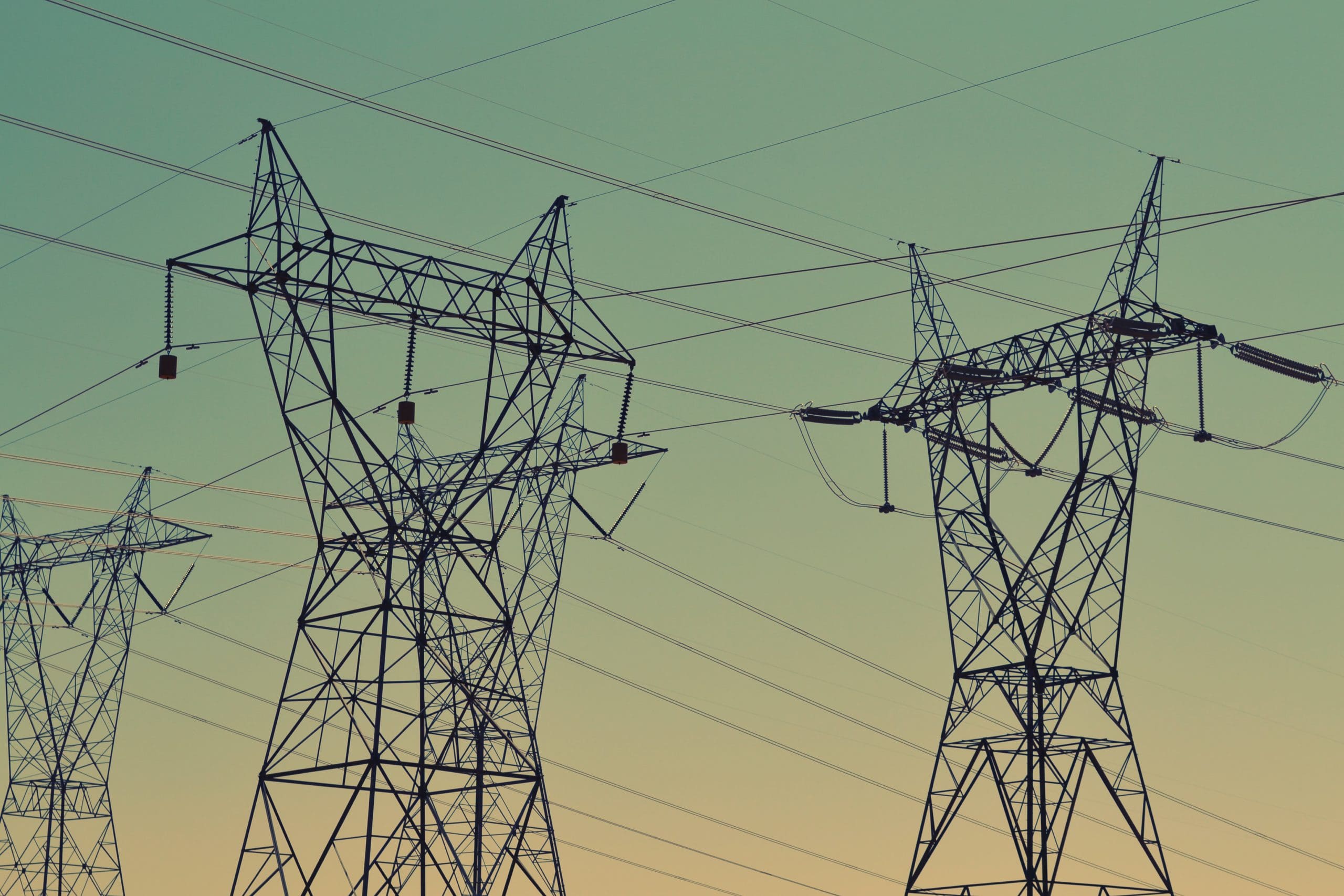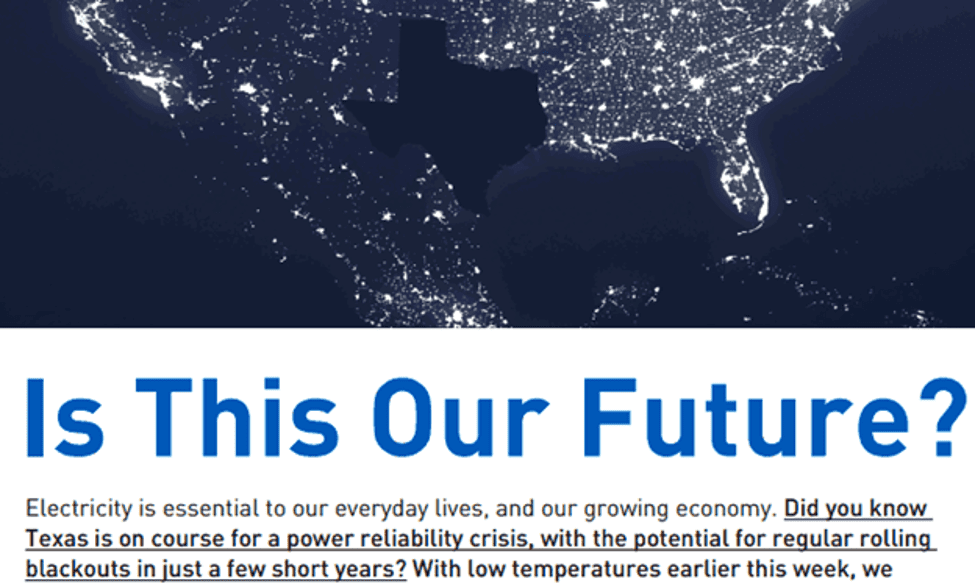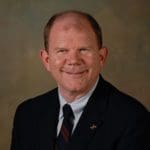With almost hundreds of thousands of Texans still without power—and many without water—everyone is looking for someone to blame.
Monday’s Dallas Morning News ran a Bloomberg Wire story that blamed the blackouts on freedom: “The extreme cold appears to have caught Texas’s highly decentralized electricity market by surprise.”
Not to be left out, State Reps. Chris Paddie and Craig Goldman and House Speaker Dade Phelan have called for a joint meeting of two committees on February 25 to “review the factors” that contributed to this “unacceptable” situation.
I’ve been listening to the podcast of Wednesday’s Rush Limbaugh show. One of the things his wife Kathryn said about him was that “he made the most complex issues simple to understand.” While I could never do this with the expertise of Mr. Limbaugh, I do believe that it is possible to “review the factors,” cut through the chaff that will soon be coming your way, and get to the bottom of what happened.
The first cause of the blackouts is easy to identify: Texas experienced a winter storm of historic proportions. The 10 inches of snow that hit Midland set an all-time record, easily surpassing the 1951 record of 2.5 inches. Brownsville reported snow for only the third time since 1898. And Austin’s 6.5 inches of snowfall was its most since 1967.
Many details will soon be coming to light, but most of the grid was probably about as prepared as could be expected for this record storm. However, one part of the grid was mostly unprepared: renewable energy generators.
Renewables Were a No-Show
This leads us to the second, and likely primary, cause of the blackouts: renewable energy subsidies.
At 1:25 Monday morning, when the Electric Reliability Commission of Texas (ERCOT), the grid operator for most of Texas, announced that it would “instruct utilities to begin rotating outages, wind was basically a no-show. During the critical four-hour period from 10 p.m. to 2 a.m. when ERCOT was forced to begin rolling blackouts, actual wind output averaged less than 5 percent of the ERCOT load. This was down from about 58 percent during the same period the week before. It would be hard to overstate the damage caused by wind’s unreliability Sunday night—or the harm and costs its intermittency causes on a regular basis.
At the same time, solar (the most rapidly growing energy source in Texas) was where it is every night—off the grid, for the simple reason that the sun was not shining. Some might claim this is no big deal because solar is not designed to generate electricity at night. Exactly. Solar’s primary design feature also proved to be its main design flaw Monday night.
Of course, supporters of wind energy are already out defending it, trying to deflect the blame elsewhere. Ross Ramsey at The Texas Tribune claimed “frozen wind turbines in Texas caused some conservative state politicians to declare Tuesday that the state was relying too much on renewable energy. But in reality, the lost wind power makes up only a fraction of the reduction in power-generating capacity that has brought outages to millions of Texans across the state during a major winter storm.”
Reliable Generation Forced Off the Grid
ERCOT’s numbers above do a better job than anything else in refuting the claims of the wind defenders. Yet they only tell a part of the story of why renewables are the main factor underlying the blackouts. Over the last five years, wind and solar generation have dominated new power plants coming online in Texas. Wind generation’s output has increased by 113 percent, and solar’s by almost 2,000 percent. This growth has crowded out almost all investments in other types of more reliable and affordable generation such as natural gas and coal. Gas-fired generation is up only 3.5 percent during this period. Coal’s output is down 30 percent.
Why would investors build new intermittent sources of generation in Texas like wind and solar that do not show up when needed? And that cannot take advantage of the higher prices during times like these? The sole cause for this is renewable energy subsidies.
From 2006 to 2019, wind and solar generators in Texas received about $19.4 billion in subsidies and benefits from taxpayers and consumers. In 2018, about 28 percent of renewable generators’ income came from subsidies. Investors have flocked to these subsidies. And why shouldn’t they? On the other hand, investors are spurning natural gas and coal because without the massive subsidies offered to wind and solar, new natural gas plants are hard-pressed to compete.
Because of market distortions created by renewable subsidies, when Texas ran low on electricity Sunday night, the grid operator had nowhere to turn. Reliable natural gas plants that could have shouldered much—if not all—of the heavy load were nonexistent because they had not been built, thanks to renewables subsidies.
We Had Plenty of Warning
Finally, it is important to understand that Texas did not arrive at this condition overnight. For years, it has been obvious to everyone that renewables have been worsening the stability of the Texas grid.
In 2012, Public Utility Commission of Texas (PUC) Chairman Donna Nelson explained the problems caused by renewable energy subsidies to the Texas Senate:
Federal incentives for renewable energy … have distorted the competitive wholesale market in ERCOT. … The market distortions caused by renewable energy incentives are one of the primary causes I believe of our current resource adequacy issue… [T]his distortion makes it difficult for other generation types to recover their cost and discourages investment in new generation.
In 2019, Texas state Sen. Kelly Hancock authored a bill that would have required the PUC to study how to deal with the problem caused by renewable energy subsidies. The Texas Senate passed the bill with strong bipartisan backing, but the bill was killed in the Texas House State Affairs Committee, chaired by current Speaker Dade Phelan, when lobbyists for renewable energy companies and environmental groups rose up in opposition.
Even without the bill, however, the PUC could have taken steps to address the harms caused by renewables. Instead, its commissioners caved to the demands of generators for more subsidies to paper over the problem. The Texas Tribune reported in 2018, “Major power generators including Calpine, Exelon and NRG are asking the commission to tweak an existing formula known as the operating reserve demand curve (ORDC) to increase the amount of money they receive when demand for power escalates.”
Advertisement from Generators Seeking to Increase Subsidies
Source: Austin American-Statesman
Through tweaking an administrative price adder that it had previously adopted, the PUC increased wholesale electricity prices in 2019 by $3.6 billion. As The Houston Chronicle reported that the money flowed straight into generators’ pockets: “The higher prices helped [NRG] convert a $72 million third-quarter loss in 2018 into a $372 million profit for the same period in 2019.”
As has become obvious this week, there is no indication that any of this money made its way back into the market in the form of new, reliable generation. Instead, generators and Wall Street doubled down on renewables. The obvious fault in this was noted this week by Dana Perino on Fox News Channel’s The Five, “Fingers crossed for good weather is not a sound policy.”
Conclusion
Perhaps at next week’s hearing, fingers will be pointed at regulators, grid operators, and generators. And though they must certainly share some of the blame, the ultimate responsibility for the loss of power this week rests in the Texas Legislature, Governor Greg Abbott, Lieutenant Governor Dan Patrick, and Speaker Dade Phelan. For years, they have sat by and watched corporations with multi-billion market caps fleece Texas consumers and taxpayers while being unwilling to take on one of the left’s favorite causes: renewable energy. The greatest danger Texans now face is the political establishment’s continued unwillingness to challenge the renewable lobby.
Fortunately, there is a simple path to reform.
First, the Texas Legislature must this session eliminate all subsidies and benefits for renewables in Texas. These include the state’s renewable energy credit program, property tax abatements under Chapters 312 and 313 of the Texas Tax Code, and subsidized transmission across hundreds of miles of Texas.
Second, the Legislature must direct the PUC to require that wind and solar operators rather than consumers bear the costs their intermittency and federal subsidies impose on the grid. Texas cannot stop the federal subsidies renewable generators receive, but it can stop most of their harmful effects.
Third, the Legislature must end the PUC’s constant intervention in the Texas electric market. It can start by eliminating the ORDC’s electricity tax and other so-called “reliability adders” that distort market operations. Additionally, the Legislature can also eliminate price caps, restrictions on generation ownership, and archaic antitrust measures that hinder investment in the Texas market.
Texas has something no U.S. state has established—a competitive (though still regulated) electricity market. It has functioned well over the years, providing Texans with a reliable and affordable supply of electricity. However, we have seen this week how special interests and overzealous regulators have slowly compromised the ability of the market to meet the needs of Texans. The Texas Legislature must act decisively this session to eliminate our reliance on renewable energy and implement free-market reforms, or the situation will only get worse.
This is a commentary published with the author’s permission. If you wish to submit a commentary to Texas Scorecard, please submit your article to submission@texasscorecard.com.








